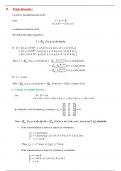II. Triple integrals :
Let Ω be a bounded domain in ℝ3 .
And : 𝑓 ∶ Ω ⟼ ℝ3
(𝑥, 𝑦, 𝑧) ⟼ 𝑓(𝑥, 𝑦, 𝑧)
a continuous function on Ω.
We define the triple integral by :
𝑰 = ∭𝛀 𝒇(𝒙, 𝒚, 𝒛). 𝒅𝒙 𝒅𝒚 𝒅𝒛
If : Ω = {(𝑥, 𝑦, 𝑧) ∈ ℝ3 ; 𝛾1 (𝑥, 𝑦) ≤ 𝑧 ≤ 𝛾2 (𝑥, 𝑦) ; (𝑥, 𝑦) ∈ 𝐷𝑥𝑦 }
= {(𝑥, 𝑦, 𝑧) ∈ ℝ3 ; 𝜓1 (𝑥, 𝑧) ≤ 𝑦 ≤ 𝜓2 (𝑥, 𝑧) ; (𝑥, 𝑧) ∈ 𝐷𝑥𝑧 }
= {(𝑥, 𝑦, 𝑧) ∈ ℝ3 ; 𝜑1 (𝑦, 𝑧) ≤ 𝑧 ≤ 𝜑2 (𝑦, 𝑧) ; (𝑦, 𝑧) ∈ 𝐷𝑦𝑧 }
𝛾 (𝑥,𝑦)
Then : 𝐼 = ∭Ω 𝑓(𝑥, 𝑦, 𝑧) 𝑑𝑥 𝑑𝑦 𝑑𝑧 = ∬𝐷 (∫𝛾 2(𝑥,𝑦) 𝑓(𝑥, 𝑦, 𝑧)𝑑𝑧) 𝑑𝑥𝑑𝑦
𝑥𝑦 1
𝜓 (𝑥,𝑧)
= ∬𝐷 (∫𝜓 1(𝑥,𝑧) 𝑓(𝑥, 𝑦, 𝑧)𝑑𝑦) 𝑑𝑥𝑑𝑧
𝑥𝑧 2
𝜑1 (𝑦,𝑧)
= ∬𝐷 (∫𝜑 (𝑦,𝑧) 𝑓(𝑥, 𝑦, 𝑧)𝑑𝑥) 𝑑𝑦𝑑𝑧
𝑦𝑧 2
If : 𝑓 = 1 on Ω :
Then : ∭Ω 𝑓(𝑥, 𝑦, 𝑧). 𝑑𝑥 𝑑𝑦 𝑑𝑧 = ∭Ω 𝑑𝑥 𝑑𝑦 𝑑𝑧 = 𝑉(Ω) (volume of Ω).
❖ Change of variable theorem :
Let : 𝜙 ∶ Ω′ ⟼ Ω
(𝑢, 𝑣, 𝑤) ⟼ (𝑥 = 𝑥(𝑢, 𝑣, 𝑤) , 𝑦 = 𝑦(𝑢, 𝑣, 𝑤) , 𝑧 = 𝑧(𝑢, 𝑣, 𝑤))
𝜕𝑥 𝜕𝑥 𝜕𝑥
𝜕𝑢 𝜕𝑣 𝜕𝑤
𝜙 is bijective if its Jacobian 𝐽𝜙 is nonzero : 𝐽𝜙 = | |𝜕𝑦 𝜕𝑦 𝜕𝑦 |
≠0
𝜕𝑢 𝜕𝑣 𝜕𝑤|
𝜕𝑧 𝜕𝑧 𝜕𝑧
𝜕𝑢 𝜕𝑣 𝜕𝑤
Then : ∭𝛀 𝒇(𝒙, 𝒚, 𝒛) 𝒅𝒙 𝒅𝒚 𝒅𝒛 = ∭𝛀′ 𝒇(𝒙(𝒖, 𝒗, 𝒘) , 𝒚(𝒖, 𝒗, 𝒘) , 𝒛(𝒖, 𝒗, 𝒘)) | 𝑱𝝓 |. 𝒅𝒖𝒅𝒗𝒅𝒘
▪ If the transformation is done for spherical coordinates :
𝑥 = 𝑟 cos 𝜃 sin 𝜑
{ 𝑦 = 𝑟 sin 𝜃 sin 𝜑 ; {𝑟 ≥ 0 , 0 ≤ 𝜃 ≤ 𝜋 , 0 ≤ 𝜑 ≤ 2𝜋}
𝑧 = 𝑟 cos 𝜃
Then : 𝐽𝜙 = −𝑟 2 sin 𝜑 ⟹ | 𝐽𝜙 | = 𝑟 2 sin 𝜑
▪ If the transformation is done for cylindrical coordinates :
𝑥 = 𝑟 cos 𝜃
{ 𝑦 = 𝑟 sin 𝜃 ; {𝑟 ≥ 0 , 0 ≤ 𝜃 ≤ 2𝜋 }
𝑧=ℎ




